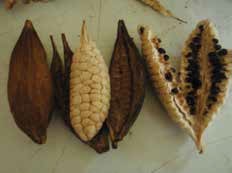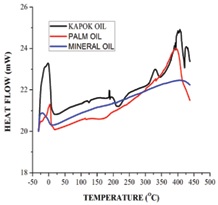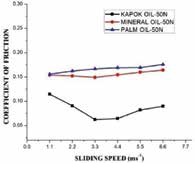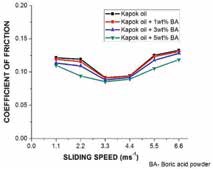Evaluation of Tribological Properties on Ceiba Pentandra (Kapok) Seed Oil as an Alternative Lubricant for Machining Applications
Introduction
The decrease in availability of mineral oils and their environmental hazards created the need to search for the alternate bio-based oils. The aim of this study is to investigate the friction and wear characteristics of kapok (Ceiba pentandra) oil as bio-lubricant using pin-on-disk tribometer under different loads of 50N and 150N various sliding speeds respectively. The test is carried out an one hour operation time at room temperature. Also, the obtained results were compared with the palm oil and mineral oil (SAE20W 40). The test is repeated with the mixture of 1, 3, 5wt% of boric acid with the kapok oil. This mixture reduces the friction and wear rate considerably. Further, from the analysis, it is found that the coefficient of friction varies proportionally and wear rate varies inversely with the sliding speed as expected.
Further, in this work an effort was made to machine the Mild Steel (AISI 1020) steel using keyway milling
process by analysing the surface roughness, and flank wear of the tool and Tool Condition Monitoring system is
designed based on the acoustic emission and vibration signatures while using kapok oil as an cutting fluid. The experiments are carried out based on the Response Surface Methodology Central Composite Design, Design of
Experiments. The statistical parameters significantly increase for dull tool. The result shows that the extracted
features increases consecutively with increase in flank wear. The present results confirm that the kapok oil can
be used as an alternative lubricant to reduce the demand for mineral based oil lubricants.
  |
|
Kapok Seed and Oil Properties |
Tribological Study Results |
Achievements
In this work, a detailed study on the tribological properties of kapok (Ceiba Pentandra) oil as a bio-lubricant using pin-on-disk tribometer under different loads and rotating speeds were performed. Further, the kapok oil was used as a cutting fluid for milling operation and their vibration and cutting force were determined. The result shows that both coefficient of friction and wear rate were higher for 150N than the 50N applied load for all the lubricants at different sliding speeds respectively. The coefficient of friction and wear rate for the specimen lubricated with kapok oil showed lower value than the mineral oil and palm oil. From the surface texture analysis, it was found that there exists abrasive wear for kapok oil and palm oil lubrication.
For mineral oil lubrication, mild adhesive wear exists. The kapok oil with the higher percentage of oleic acid
possess the low coefficient of friction and wear rate, because the oleic acid forms the oxide monolayer over the
surface that reduces the asperity contact between sliding surfaces. The wear rate decreases with the increase
in sliding speeds for all the lubricants. This is due to the increase in temperature which forms an oxide layer
at higher sliding speeds that protect from wear. Both wear rate and coefficient of friction decreases with the
addition of boric acid powder with kapok oil. 5wt% boric acid provides the optimal result compared to the other
combinations. The optimal process parameter for flank wear and surface roughness were found i.e. spindle
speed of 647 rpm, feed rate of 0.09 mm/rev and depth of cut of 1.20 mm while using kapok oil as cutting
fluid. It is clear that the feed rate had the most physical significance for the flank wear and surface roughness.
The measured vibration and sound signatures show that the increase in wear leads to increase in the resultant
vibration and sound pressure.
For further information please contact
Kongu Engineering College
Perundurai, Erode
Tamilnadu 638060
Email : shankariitm@gmail.com









